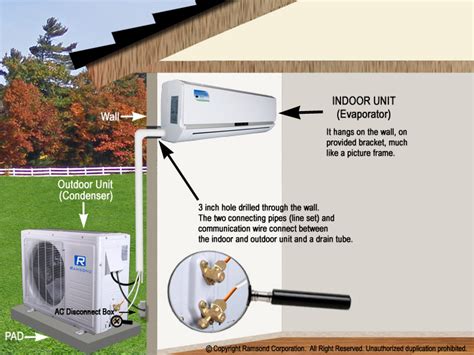How to Run Drain Pipe for a Mini Split System: A Comprehensive Guide
Installing a mini-split system is a significant undertaking, but properly managing condensate drainage is crucial for its long-term efficiency and lifespan. This guide walks you through the process of running drain pipe for your mini-split, covering everything from planning to installation. Ignoring proper drainage can lead to leaks, mold growth, and costly repairs, so paying close attention to this detail is essential.
Understanding Mini-Split Condensate Drainage
Mini-split systems produce condensate—water vapor that condenses from the air—during their cooling cycle. This water needs to be safely removed from the indoor unit. Improper drainage can lead to:
- Water damage: Leaks can damage ceilings, walls, and floors.
- Mold and mildew growth: Standing water provides an ideal breeding ground for harmful mold.
- System malfunction: Clogged drains can cause the system to shut down.
Planning Your Mini-Split Drain Line
Before you start, careful planning is crucial:
1. Determine Drain Line Location:
- Gravity Drain: The simplest method utilizes gravity to drain the condensate. Identify the lowest point near the indoor unit where you can run the drain line. This often involves running the line to a floor drain, a nearby drain, or even outside to a suitable location, provided local codes allow.
- Pump System (for above-ground drainage): If gravity drainage isn't feasible, you'll need a condensate pump to move the water upward. This is commonly used when the drain needs to travel uphill or over longer distances.
- Check Local Codes: Familiarize yourself with local plumbing codes and regulations concerning condensate drainage.
2. Material Selection:
PVC pipe is the most common choice for condensate drain lines due to its durability, affordability, and resistance to corrosion. Choose a pipe with a diameter appropriate for your mini-split's condensate output (usually 1/2" or 3/4" PVC).
3. Route Planning:
- Concealment: Plan the route carefully to minimize visibility. Running the line inside walls or ceilings is ideal, provided you can access these spaces.
- Slope: Ensure a consistent slope (typically 1/4 inch per foot) towards the drain point to facilitate gravity drainage. If using a pump, this is less critical.
- Accessibility: Consider future access for cleaning or maintenance. Avoid completely sealing the line within walls where it might be difficult to reach if a blockage occurs.
Installing the Mini-Split Drain Line
Once you've planned your route, follow these steps for installation:
1. Cut and Assemble the PVC Pipe:
- Measure and Cut: Accurately measure and cut the PVC pipe to the necessary length.
- Connectors: Use PVC connectors (elbows, tees, etc.) to create the desired path.
- Primer and Cement: Use PVC primer and cement to securely join the pipe sections and ensure a watertight seal. Allow sufficient drying time according to the manufacturer's instructions.
2. Secure the Pipe:
- Clamps: Use pipe clamps to secure the pipe along its route, preventing sagging and ensuring proper slope.
- Support: Provide adequate support to prevent the pipe from breaking under stress.
3. Connect to the Drain:
Connect the drain line to the mini-split's drain port and to the chosen drain point (floor drain, drain pipe, or external drainage).
4. Testing the Drain Line:
Before closing up walls or ceilings, thoroughly test the drain line by running water through it to check for leaks or blockages.
Using a Condensate Pump (if needed)
If gravity drainage isn't an option, a condensate pump is essential.
1. Pump Selection:
Choose a pump with a sufficient capacity to handle your mini-split's condensate output.
2. Pump Installation:
Follow the manufacturer's instructions carefully for proper installation and connection to the drain line and power supply.
3. Testing the Pump:
Test the pump's functionality after installation to ensure it pumps water effectively.
Important Considerations:
- Professional Installation: While DIY is possible, consider professional installation, especially for complex situations or if you lack experience with plumbing.
- Regular Maintenance: Periodically check your drain line for blockages or leaks. Cleaning might be necessary to prevent clogs.
By following these steps, you can ensure proper condensate drainage for your mini-split system, protecting your investment and maintaining a comfortable indoor environment. Remember, safety should always be your top priority. If you're unsure about any aspect of this process, consult a qualified HVAC professional.
